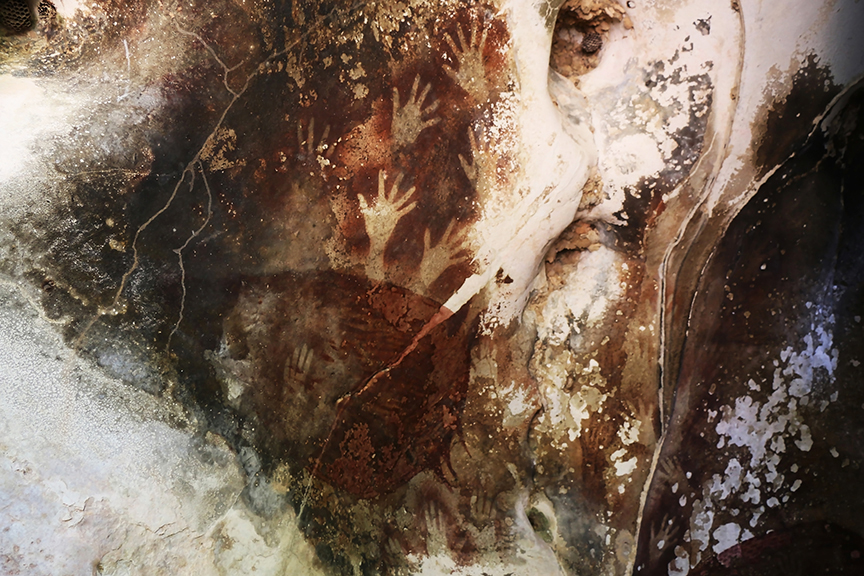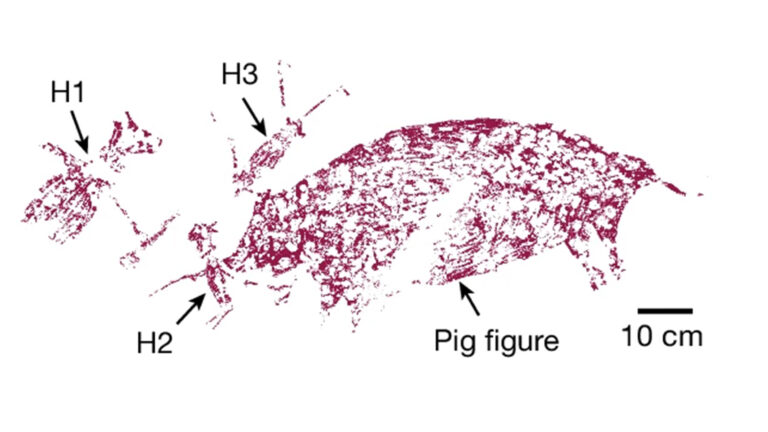Scientists have discovered a painting of three human figures surrounding a large pig in a cave on the island of Sulawesi, Indonesia. Using a new technique that involves laser-sampling tiny pieces of the pigment for analysis, they have dated the work to 51,200 years old, 5,000 years older than the oldest known cave painting.
They also re-dated other artworks from the same cave complex, putting them at about 49,000 years old, 4,000 years older than originally thought. The multiple laser samplings do not significantly damage the artworks, but they do give a much more accurate reading.
Figures from the article published in the journal “Nature”. Images: Adhi Agus Oktaviana et al.
These findings could radically change our understanding of when humans began producing art.
“This discovery reinforces the idea that figurative art was first produced in Africa, 50,000 years ago, and that the concept spread as our species spread,” Chris Stringer of the Natural History Museum in London told the BBC.
“If this is true, much further evidence from other regions, particularly Africa, remains to be provided… Hopefully more dating will be done at more sites to confirm this apparently crucial discovery.”
Europe or Africa?
Until a decade ago, many scholars believed that figurative art appeared in southern Europe between 30,000 and 40,000 years ago. Indeed, the animal and human figures painted in French and Spanish caves date from this period or earlier. Until recently, they were the oldest known examples of this art form.
That all changed in 2014, when scientists discovered similarly ancient cave paintings in Sulawesi. Other discoveries in Borneo date back to the same period.

The colorful outlines of human hands discovered in 2014 in Sulawesi were the oldest rock art until the latest discovery. Photo: Shutterstock
The new research from South Sulawesi, published in the journal Natureseems to confirm this idea. The modest painting depicting pigs and humans is now officially the oldest known figurative rock art. Some older engravings on the walls of caves in southern Africa show only simple geometric patterns, not figures.

The cave where the paintings were discovered. Photo: National Research and Innovation Agency (Indonesia).
“Humans have probably been telling stories for much longer than 51,200 years, but because words don’t fossilize, we can only rely on indirect approximations like depictions of scenes in art,” said team leader Adhi Agus Oktaviana, an Indonesian rock art expert.
“The art from Sulawesi is by far the oldest evidence of this type known to archaeology.”
New Horizons
Until now, scientists studied the mineral deposits that accumulated on cave walls over millennia. The old technique made it difficult to determine precisely when the different layers had accumulated. It simply wasn’t precise enough. It also required large samples of the cave art—or at least, larger ones than those tasked with preserving the work wanted.
The new dating technique, called U-series laser ablation (LA-series) imaging, has several advantages over the previous approach. As the scientists explain in their paper, LA-series dating is fast and cost-effective, requires smaller samples, is less destructive, and is more accurate.
Hopefully, this technique will help re-date other sites around the world. It’s just one more example of a long-standing truth: in the world of early human archaeology, a new discovery, a recent breakthrough, or a new gadget can change everything.

The famous cave art at Lascaux in France is only 17,000 years old. Photo: Shutterstock


